
HOME • REVIEWS • CONTACT • LINKS • ARCHIVES • FORUMS
 |
| HOME • REVIEWS • CONTACT • LINKS • ARCHIVES • FORUMS |

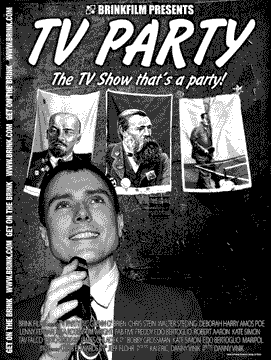
Compared to its distant past, present-day New York City is pretty tame, a glossy, sterilized, Starbucks-infested version of the barren, decaying city it was only 25 years ago. In his essay, �My Lost City,� Luc Sante writes, �In the 1970s New York City was not a part of the United States at all. It was an offshore interzone with no shopping malls, few major chains, very few born-again Christians who had not been sent there on a mission.� Though I can only base my impressions of New York�s past on Sante�s essay and similar texts and films, I often pine for the days when the city was actually dangerous, when underground movements hadn�t yet been commodified into marketable products, when it didn�t cost $2000 a month to live in a tiny studio on the Lower East Side, when you could look out your window and see tenement buildings burning in Alphabet City, set aflame by their owners to collect insurance money, when new music and art was actually exciting and ground-breaking, when you could wander into a club on any given night of the week and see bands like DNA or the Testors. I often find myself imagining what might have been if I were born in, say, 1960, or maybe even a little earlier, 1950 (so I could see the Velvet Underground, of course.) In those days, you could actually be an artist, writer, or musician in New York City, and live off of your art. Glenn O�Brien paid the $100 a month rent on his East Village apartment by selling unwanted review copies of albums to St. Mark�s Records, most of his efforts spent on writing freelance articles for magazines like Interview and High Times, partying at the Mudd Club, and filming TV Party, a public access show that he hosted from 1978 to 1982.
TV Party was �the TV show that�s a cocktail party but which could also be a political party,� conceived by O�Brien after Coca Crystal, who he knew from High Times, invited him to appear on her cable access show, If I Can�t Dance You Can Keep Your Revolution. Glenn thought nothing of it until the next day when people started stopping him on the street, saying they�d seen him on TV the night before. It was at this point that he realized the power of TV: �My God, people are actually watching channel B,� he remembers thinking in TV Party, a 2005 documentary about the show. �I�d always thought the country was ruled by television, that that was the means by which people were controlled.�
TV Party, as Glenn and cast saw it, involved �the people seizing television and using it for democratic purposes,� erasing the distinction between the guests and the audience. That is, anyone who was good enough to be in the audience was good enough to be on the show��if you can find it, you can come.� At the time, public access television was a relatively new concept, and to creative individuals like Glenn, it was the equivalent of punk rock, providing a forum where anyone could be on TV if they so desired, could say or do just about anything before an audience of thousands��leveling the playing field,� as Glenn writes in �The TV Party Story,� an article that can be found on the film�s web site as well as in the DVD booklet.
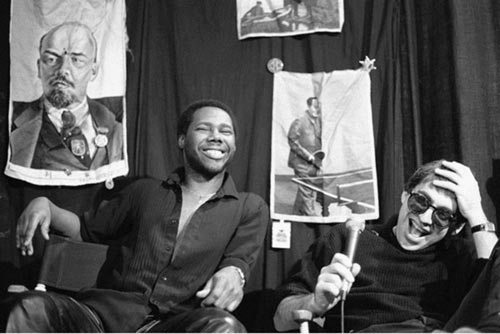
The show wasn�t based on Johnny Carson�s standard talk show format as much as it was on Hugh Hefner�s Playboy After Dark, a talk show in the form of a sophisticated cocktail party. However, there were similarities between TVP and the former�Blondie guitarist Chris Stein was seen as the Ed McMahon figure to Glenn�s Johnny, and violinist Walter Steding was their Doc Severinsen.
The �political party� aspect could be interpreted as stemming from their DIY approach��guerrilla TV,� as George Clinton calls it in one episode�the means of production making the biggest statement. One gets the impression, however, that its participants felt the show�s content to be politicized as well, although their views at times seem a little hazy, perhaps not exceeding hanging posters of Mao and Lenin on the walls in the studio. Glenn did intend to get the �TV Party� on the ballot and run for mayor of New York (�Some people like Democrat and some people like Republican but everybody loves TV�) and went as far as actually getting petition forms, but they never bothered to get any signatures.
People who wanted their own public access show had two options: to pre-tape it, or to film it live in the studio, of which Glenn chose the latter, remembering watching live television shows as a child, wherein a set might fall down, or someone would blow a line�in other words, anything could happen.
E.T.C. Studios was run by Jim Chladek, who Glenn often describes as the teacher type, quietly disapproving of their actions, scolding them for smoking in the studio. They were provided three cameras and numerous microphones, half of which were broken. As Glenn writes in �The TV Party Story,� �it would have been difficult for real technicians to produce a visible, audible show here, and we weren�t technicians.�
None of the TVP gang really knew how to use the studio�s equipment. As a result, the sound would sometimes cut out, or an attempt at taking a call from a viewer would result in screeching feedback. Every so often the camera went out of focus. Some might find such technical faux pas off-putting, but to me it�s all part of the charm.
Glenn asked his friend, Amos Poe, whose reputation for making bad movies seems more than appropriate to the show�s aesthetic, to direct TV Party. Poe�s vision for the show, if he had one at all, differed from what one might expect of a television program. He would tell the camera operators to shoot people�s feet�Glenn wears New Balance�or the person who wasn�t talking. �Then he would push the control panel buttons, switching cameras in time with the music, or go nuts on the fader, putting images on top of one another. Sometimes it looked more like a light show from the Fillmore than a TV show,� O�Brien recalls in �The TV Party Story.� In the film, Debbie Harry says that at times she couldn�t watch the show, calling it �toxic to look at.�
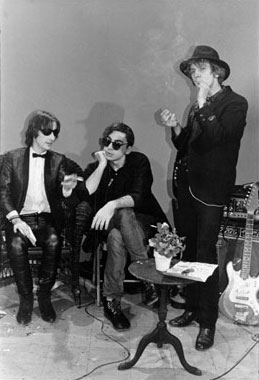
When Poe couldn�t make it to a taping, Glenn would pick someone else from the TVP gang to direct: �People would protest �I don�t know how!� and I�d say �Good!�� A fan of Andy Warhol�s films, which include Sleep, a five-hour film of a man sleeping, and Empire, an eight-hour single shot of the Empire State Building, Glenn felt an affinity towards �bad� camerawork and a lack of technical slickness, aspiring to break all the rules of good broadcasting��sometimes we would sit around and say �Well, what should we do now?...They say �dead air� is the kiss of death in broadcasting, but we liked it.�
As any good talk show would, TV Party had an orchestra of sorts, which regularly consisted of Walter Steding, a violinist who wore a synthesizer on his belt and often played downtown clubs as a one-man band, Chris Stein on guitar, Tim Wright of DNA and Pere Ubu on bass, and Lenny Ferrari on �drums:� they weren�t allowed to bring actual drums in the studio, so the TV Party kit consisted of a music stand, tiny cymbals, some Quaker Oats cans, and a copy of The New Yorker magazine.
Many hip New York musicians would drop by and sit in with the orchestra, including ex-San Franciscan Snuky Tate, actor and saxophonist John Lurie, King Crimson�s Robert Fripp, and David Byrne of The Talking Heads. The band was usually noisy, often droning and repetitive, and generally sounded fairly improvised; they wouldn�t have been out of place on a bill with no-wave contemporaries like Teenage Jesus & The Jerks or the Contortions. The show would usually start with the band playing, sometimes for ten minutes before anything else happened.
TV Party had a rotating cast of regulars, including Debbie Harry, Richard Sohl of the Patti Smith Group, who served as TVP�s telephone operator, artist Jean-Michel Basquiat, future Yo! MTV Raps host Fab Five Freddy, model Lisa Rosen, and DNA�s Arto Lindsay, among many others. The gang filled roles where necessary, operating the cameras, working in the control room. Basquiat occasionally appeared on camera, but preferred to stay behind the scenes, feeling most at home typing on the character keyboard, which generated text that appeared onscreen. His use of the keyboard paralleled his graffiti, which was heavily text-oriented. At any given moment, one might see phrases like �Death is Rolaids,� �Yes you are a racist,� or just plain �NONONONONONONAAAAAAAAAAAAA?!?!?!?!� trailing across the screen. Basquiat was also notorious for drawing and painting on everything, including other people�s personal belongings. In �The TV Party Story,� Glenn writes of one particular instance, when Jim Chladek had just gotten a pristine piece of seamless paper for a backdrop, and Jean-Michel wrote on it in magic marker: �MOCK PENIS ENVY.� Chladek was horrified and they had to pay for the seamless. One can see it clearly written in the background during the Heavy Metal themed episode.
The show also featured a slew of special guests, most of whom weren�t celebrities (one exception being David Bowie), but were close to it, stars of the hip downtown scene and beyond, including Klaus Nomi, Mick Jones of the Clash, photographer Robert Mapplethorpe, Iggy Pop, James Chance, and George Clinton, to name a few. Sometimes the guests were a little weirder�on the premier episode, Robert Delford Brown appears, credited as starting the Church of Exquisite Panic, which was, as Brown explains, �introducing humor back into religion.� (Glenn asks, �Who was the last funny saint?�)

Bands often played live in the studio, which provided for an interesting adaptation of their sound, in that they had to use the TV Party kit, and usually had the orchestra playing as the backing band�when Blondie plays �The Tide Is High� you can hear an electric violin in the mix. Other musicians featured on the show included Tav Falco of Panther Burns, Gun Club�s Jeffrey Lee Pierce, DNA, Tuxedomoon, the Fleshtones, and the Brides of Funkenstein, among countless others.
Drugs were also a significant factor of TV Party, one might even say an inherent part of the show. Oddly enough, the cast wasn�t allowed to smoke cigarettes in the studio, but because pot was in the �script,� they could get away with it. Guests can often be seen passing joints in the background, and the various kinds of pot were frequently discussed on the show; in one episode Glenn tries to roll a joint while blindfolded. In the film, Fab Five Freddy likens their lighting up good weed to Letterman�s cup of coffee, while on one episode of TVP, Glenn informs a caller that �if the camera is steady, there�s a lack of good drugs in the studio.� Most of the show�s participants were stoned; the gang usually hung out at a bar called the Blarney Stone prior to taping, staying there until they were in the right state of consciousness to do the show. TV Party aired following The Robin Byrd Show, a porno talk show, �which was one of the best things that happened to us. We inherited a large audience from Robin. I suspect many of our viewers had lingering erections, which might explain some of the phone calls we received,� Glenn recalls in �The TV Party Story.� The call-in segment, in which viewers were able to share what they were thinking�to, in other words, talk to the people inside the TV�was, perhaps, one of the show�s most memorable aspects. Callers were often hostile and aggressive, uttering such choice lines as �Hello? Is this is TV Party? Yeah, your mother takes it in the ass you fuckin� black cocksucker,� �Can I jerk off on your mother�s face you prick faggot� and the oft-uttered �You�re all fags.� Once in a while, someone would attempt to make constructive suggestions (�It would be really helpful if you got somebody who was able to work the camera,�) and sometimes they seemed just plain puzzled: �What is this show supposed to be about?� Some callers were fans of the show, while others proclaimed that TV Party had �destroyed punk rock.� (To which Glenn replies in his dry, deadpan style, �Hey, all right! That�s what we�ve been trying to do all along, and I�m glad the CIA gave us the $60 to do the show so we could destroy punk rock, the filthy foul��)
The show seemed to get many frequent, repeat callers�on one episode the same high-pitched voice continually instructs them to call a certain phone number (�are you gonna call 799-1500 or what?�), and on another episode someone asks Debbie Harry which member of the TVP orchestra is the best fuck. (She replies, �You�ve already called about this!��he later calls back and asks Chris Stein which member of the Ramones gives the best head.) Usually, the cast seems to revel in such calls, but at times they seem frustrated and disappointed with their audience. In one episode, Glenn interviews Basquiat, then opens up the phone lines in, ostensibly, an attempt to engage viewers in a dialogue with the artist. After some brief discussion of graffiti, someone calls asking Glenn to remove his shirt, Glenn cutting him off with the curt reply, �This isn�t the point of the show.�
While they sometimes just winged it, the shows often had a theme; theme nights included Heavy Metal night, Cowboy night, Crusades night, Middle Eastern night, Primitive night, Pajama Party night, and TV Party At Home, which showed viewers what they looked like while watching TV. (At the start of the episode, which simply filmed Glenn�s empty apartment, viewers were instructed that if they got bored, they should go to the Mudd Club, where the cast would actually be.)
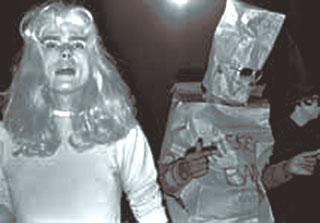
On the 1979 Halloween episode�my favorite of the four that were released on DVD�Chris Stein is dressed as a wicked witch, Debbie Harry as an umbrella, Glenn in what the back of the DVD describes as a �casual Dolly Parton lesbian look� (he can be seen fixing his boobs), and Freddy is a nickel bag, a paper bag over his head and body, with armholes cut out. Glenn later interviews the nickel bag�addressing him as Mr. Bag (�or may I call you Nickel?�)�who warns children about the drugs that might get dropped in their bags on Halloween. He laments of working all day in Harlem and not getting picked up because people don�t like his brand of pot, then goes on to offer some advice to the younger viewers: �Stay away from Dilaudids, kids.� Towards the end of the show, Glenn asks the gang what kind of treats they�d like (a trick, 50 shares of AT&T;, a party) and Debbie teaches everyone a dance called �The Subway.� At the end of the show, phone calls are still coming in while the gang dances, one of whom thanks them, because he�d forgotten it was Halloween until he turned on the TV.
There were eventually some attempts at upgrading, perhaps even bringing the show over to mainstream media. Glenn moved the show to channel J so it could be done in color, which was more expensive, though to make up for it they could sell ads. For all of their efforts, however, the show was slowing dissolving. Glenn writes, �We might have lost something in the process. I think we all looked better in black and white.�
In 1981, the show was put on hold for about six months while they filmed the movie Downtown 81, a fictional day in the life of Jean-Michel Basquiat, in which he wanders the streets attempting to sell a painting and to find a place to sleep, drifting in and out of clubs, meeting people on the way. Just about everyone who�s ever appeared on TV Party can be spotted in the film, which, due to financial problems, remained unreleased until 2000.
Meanwhile, things were happening among the TV Party gang. Many moved away or went to rehab; Walter wanted to concentrate on his band, Dragon People, while Lenny Ferrari went on the road with Lou Reed. Chris Stein, who had lost a frightening amount of weight, discovered he had a rare genetic disease called pemphigus vulgari��luckily, after a long, long treatment period and recuperation he pulled through, but Blondie didn't and neither did TV Party.� The show never really ended, just sort of fizzled out, or, as Glenn says in the film, �went into a coma.� TV Party was often a mixed bag�it could be brilliant or boring, hilarious or stupid. Since the show was mostly improvised, sometimes it worked, and sometimes it didn�t. But when it did, the most amazingly unexpected things could happen�I suppose that�s the most significant part, that you never knew what was going to happen, the intrinsic beauty of live television. One night a caller requested that the orchestra play �Strangers In the Night,� and they did, or something closely resembling it, Walter making up the words, singing �TV Party is stranger than the night,� with the caller humming along in the background. It�s moments like these that make me love the show.
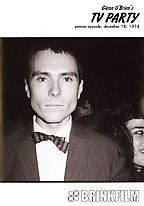
The main question I�m left with concerns whether or not TV Party could happen today. My first inclination leans toward the negative, but perhaps that�s just my pessimistic worldview. For one, smoking marijuana on the air would probably not fly, and from reading MNN�s and BCAT�s guidelines for filming live in the studio, they�re a bit stricter about who they allow to use their equipment these days. More importantly however, New York is an entirely different city, no longer the fertile breeding ground for visionaries like those who contributed to the scene in the late 1970s. Unless you�re a trust fund baby, it�s pretty hard to survive on your art, which I think was an essential factor to the creativity exploding throughout that scene. When you need to allot most of your energy to working some shitty desk job in order to pay the bills, being creative is a bit more challenging. Today�s New York hipsters�and yes, the TVP gang were hipsters, but to me the word didn�t have negative connotations until more recently�are too mired in ironic fashion trends, feeding off of past scenes instead of trying to create something new. More often than not, when bands try to imitate other bands, none of the angst or innovation of the first wave comes through in the transfer, only the most superficial qualities extracted. I�d love to be proven wrong though.
The TV Party documentary, as well as four episodes of the show, can be purchased from Brink Films.
TV Party website: www.tvparty.orgBasquiat interview on TV Party:
| PREVIOUS PAGE • HOME • NEXT PAGE |